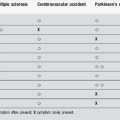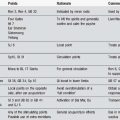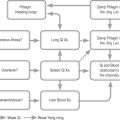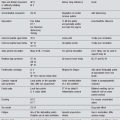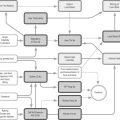5 Practical application of Western medical acupuncture in neurological conditions
Clinical reasoning framework
A clinical reasoning framework can be based around the major problems that people with neurological conditions may complain of, namely sensory, motor, visceral and generalized disorders (Table 5.1). The literature regarding these presentations has been explored in Chapter 4.
Table 5.1 Clinical reasoning framework in neurological conditions
| Key issue | Examples | Acupuncture options |
|---|---|---|
| Sensory problems |
EA, electroacupuncture.
Part 1 Sensory function
Case study 5.2: level 1: Pain from active trigger point in Brown-Séquard syndrome
Case study 5.3: level 1: Paraesthesia and dysaesthesia in transverse myelitis
Case study 5.4: level 2: Back and hip pain in choreoathetoid cerebral palsy
Comment
Acupuncture provided substantial relief of hip pain for 3 months. However it was difficult to sustain pain relief due to the extreme stresses placed upon the patient’s joints due to the choreoathetoid movements. Treatment of back pain in the presence of involuntary paraspinal spasms was very difficult and issues of safety raised by Watson [1] are relevant in this situation. Trial of TENS was more successful and provided a simple option that she could use whenever the back pain was problematic. In complex presentations it is important to remember the limitations of any one technique and involve other professionals as necessary.
Case study 5.5: level 1: Impaired sensation affecting dexterity in stroke
Comment
Studies have demonstrated improved motor dexterity following somatosensory stimulation in stroke [2]. These studies usually provide stimulation over a peripheral nerve such as the median nerve and aim for the patient to feel strong paraesthesia. This physiotherapist used points throughout the upper limb local to the area of sensory deficit, provided strong stimulation and gained improvements in sensation and motor function. In planning such treatments it would be useful to consider the peripheral nerves supplying the target areas and select points to stimulate these nerves.
Part 2 Motor function
Case study 5.6: level 1: Inability to move fingers following spinal stroke
Case study 5.7: level 2: Inability to move arm or leg poststroke
Comment
The physiotherapist was trying to understand how scalp acupuncture might influence motor ability. Papers reporting inhibition of lesioned hemisphere by the intact hemisphere seemed relevant, as well as those reporting the application of transcranial magnetic stimulation over the intact hemisphere to reduce this transcallosal inhibition and improve motor ability in stroke [3, 4]. Therefore during treatment 2 she provided electroacupuncture stimulation over the intact hemisphere. During this treatment she elicited the first active movement in 6 weeks. This sudden development of movement resembles improvements reported in Chinese texts on scalp acupuncture. We cannot be sure what mechanisms are at work in this case. However the outcome was improved motor ability so that the patient could use his right leg and begin to walk. Scalp acupuncture has received very little attention in the scientific literature despite repeated reports of benefit for cerebral conditions from China. Research seems long overdue.
Case study 5.8: level 1: Spasticity in legs affecting walking in multiple sclerosis
Case study 5.9: level 1: Dyskinesia and ‘off’ symptoms in Parkinson’s disease
Comment
The physiotherapist treating this patient had hoped to gain a reduction in the patient’s neck pain. However after a number of treatments it was obvious that his motor symptoms were also improving. This is an intriguing finding in view of the possibility that pain and dyskinesia share some common pathophysiological mechanisms [5].
Part 3 Visceral dysfunction
Case study 5.10: level 1: Overactive bladder in multiple sclerosis
Treatment
She received eight acupuncture treatments over 4 weeks, each treatment lasting 25 minutes. Electroacupuncture at 20 Hz [6] was trialled on the first treatment but this caused flexor spasms. Therefore all treatments involved manual acupuncture with no stimulation.
Points
SP 6, SP 4 bilaterally for first treatment. SP 6, LR 3 bilaterally for all subsequent treatments.
Comment
Parasympathetic outflow to the detrusor emerges at spinal levels S2–4 (see Chapter 4). SP 6 in flexor digitorum longus (S1–2) and LR 3 in the first dorsal interosseous muscle (S2–3) ensured that afferent information would arrive at relevant levels of the sacral spinal cord, with the aim that this would modulate bladder function.
Part 4 Generalized symptoms
Case study 5.13: level 1: Fatigue affecting daily activities in multiple sclerosis
Case study 5.15: level 2: Acute anxiety following traumatic brain injury
Case study 5.16: level 2: Agitation secondary to pain in stroke
[1] Watson P. Modulation of involuntary movements in cerebral palsy with acupuncture. Acupunct Med. 2009;27(2):76-78.
[2] Conforto A.B., Cohen L.G., dos Santos R.L., et al. Effects of somatosensory stimulation on motor function in chronic cortico-subcortical strokes. J Neurol. 2007;254(3):333-339.
[3] Boggio P.S., Alonso-Alonso M., Mansur C.G., et al. Hand function improvement with low-frequency repetitive transcranial magnetic stimulation of the unaffected hemisphere in a severe case of stroke. Am J Phys Med Rehabil. 2006;85(11):927-930.
[4] Murase N., Duque J., Mazzocchio R., et al. Influence of interhemispheric interactions on motor function in chronic stroke. Ann Neurol. 2004;55(3):400-409.
[5] Lim S.Y., Farrell M.J., Gibson S.J., et al. Do dyskinesia and pain share common pathophysiological mechanisms in Parkinson’s disease? Mov Disord. 2008;23(12):1689-1695.
[6] Kabay S.C., Yucel M., Kabay S. Acute effect of posterior tibial nerve stimulation on neurogenic detrusor overactivity in patients with multiple sclerosis: urodynamic study. Urology. 2008;71(4):641-645.

